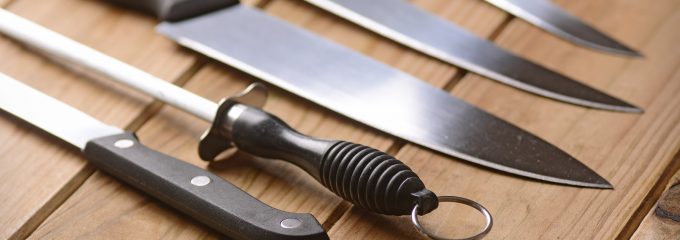How to buy knives that will last your whole life

Anyone who spends a lot of time in the kitchen knows that one’s cooking is only as good as his knife set. Cheap knives won’t hold up when you’re slicing, dicing, and chopping on a daily basis. But before you invest in a pricey set of top-shelf knives, you should really understand why they’re worth the splurge—and make sure that you’re splurging on the right set. Here’s a how-to guide for buying knives that will endure for decades to come.
First things first: decide what you need.
If you’re reading this article, then one thing is already certain: you’re a home chef—otherwise you wouldn’t go to any great lengths to pick the perfect set of knives. And as such, you need a minimum of three basic knives. Of course, there’s the versatile chef’s knife, which you’ll use for everything from slicing onions to dicing chicken. Then there’s the paring knife, a tool used primarily to peel and core fruits and veggies, and the serrated knife, which slices easily through items like bread and tomatoes.
Once you find a set with these fundamental pieces, the rest is really up to you. It all depends on what type of cooking you do and the types of ingredients you prep regularly. For instance, if you’re a vegetarian or stick to plant-based meals, a meat cleaver is rarely going to come into rotation. The same goes for a carving blade and a boning knife. And if you’re a huge fan of fresh seafood, your knife set will feel incomplete without a knife designed to fillet fish. Examine every aspect of your potential knife set before investing.
Take a test-drive.
You might be tempted to buy a set of knives online, sight unseen, but don’t let this desire for convenience drown overpower your culinary intuition. From past experience in the kitchen, you probably know that some knives move more easily than others. This depends on a wide variety of factors, from weight of the knife to the ratio of blade to handle, as well as the shape and material of the handle. The only way to find a knife that comfortably fits in your hand is by holding it in said hand and paying attention to how it feels. A knife that’s comfortable to use for 99.9% of online reviewers still might feel awkward and clunky in your hand.
Consider sharpening options.
If you’ve been considering a set of knives that claims it never requires sharpening, it’s time to cross that prospect off your list. All knives need to be sharpened eventually, no matter the quality of the blades. So take this into consideration when you’re purchasing a set of knives. Whereas carbon steel blades are simple to sharpen and require less frequent maintenance than stainless steel, they tend to rust. Stainless steel knives won’t rust as quickly, but they also dull much faster after sharpening. Stainless steel alloys bring the best elements of both knives, but get pretty pricey. Steer clear of ceramic knives for real kitchen work—they chip easily.
Find a price point that works.
And finally, once you’ve considered all the other aspects of your perfect knife set, settle on a price that fits your budget. It’s easy to spend $1,000+ on a nice set of knives, but you can find collections for $100 or $200 that will fit your needs without breaking the bank!
The Best Kitchen Knife Sets: Slice Your Way Into Cooking Today! [Foodal]
How to Buy Your Most Important Kitchen Tool: The Knife [The Federalist]
Kitchen Knife Buying Guide [Consumer Reports]